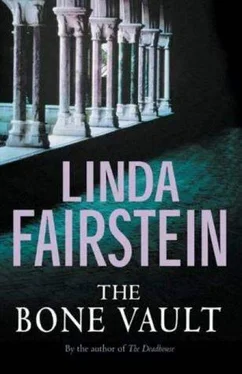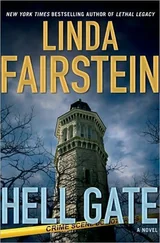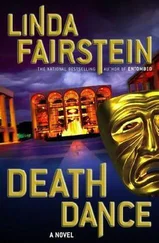Mike pointed at her leather notebook. “You take minutes?”
“Yes, I usually did.” She looked down the length of the table, at Thibodaux, as though she was seeking his advice.
“I’d like to see those.”
The director took his cue. “I’ll have Eve find them. We’ll have to figure out the relevant dates in order to do that.”
Ten minutes with Eve Drexler and you knew she could put her fingers on them in an instant. She was the assistant we all wanted. Roughly fifty years old, memory like a steel trap, polite to a fault, willing to take the heat for the boss, and compulsively organized. There was probably a diary for every day she had worked with the director.
“How long have you been assisting Mr. Thibodaux?”
“Actually, I’ve been here a few more years than he has.” She was blushing, now that the focus of the discussion had moved toher life and actions.
I tried to warm her up by engaging her on a personal level. “Would you mind telling us what your duties are?”
“Certainly, if that will help you with what you need. I came here as a graduate student almost twenty-five years ago. I was planning to spend my career as a museum archivist. That was my training, you see. But Mr. Thibodaux’s predecessor thought the things that made me such a good librarian, if you will, would be helpful to him.”
Chapman called up his childhood image of the beloved school librarian. “Tight lips? That index finger held over your mouth, going ‘ssssssssh’ while I was trying to set up a football game after school with the other guys in the stacks, huh? What else?”
Drexler smiled at his reference. “Well, he certainly appreciated discretion, yes. And my knowledge of the collection. I spent a great deal of time cataloging entries and answering questions from staff and researchers-those who were too lazy to do the work themselves. And then, when Mr. Thibodaux took charge, he was gracious enough to keep me on.”
“When was that?”
The director answered for himself. “Not quite three years ago, Detective. I’m sure you want to know everything about my background as well. Miss Drexler can give you a copy of my curriculum vitae. I’m fifty-two years old, born and raised in Paris. My experience is all curatorial. I ran the European art and sculpture department at the Louvre for more than a decade. Welcomed the opportunity to move to this gem of a museum. My wife was a New Yorker. She very much wanted to come home.”
Eve Drexler heard the knock on the door and went to open it. I recognized the man who had been outside the truck at Newark last night, whom Thibodaux had said was in charge of shipping.
“Come in, Maury.” He rose and greeted the shipping manager, a short, chunky man with a round face and thick red hair.
“Miss Cooper, Mr. Chapman, this is Maury Lissen. He is going to assist you with everything you’ll need from his department.”
Lissen took one of the seats at the table and placed the clipboard he carried in front of him.
“I’ve been up all night going over my paperwork. I just can’t see any way this could have happened here.”
“Yes, but obviously it did, Maury, and we’re going to have to help the police as best we can.”
Chapman stood and reached for the photograph of Katrina Grooten and passed it to Lissen. He winced as he looked at it. “I got a weak stomach for this kind of thing, Detective. Don’t make me look at it, okay?”
Not exactly a response that resonates with a homicide detective. Mike and his partners rarely had the luxury of encountering a body that was not decomposed, or gaping with stab wounds or gunshot holes. “Take a good look, Maury,” he said, sticking the shot back under the guy’s nose. “She can’t bite. She’s dead.”
He wouldn’t pick up the photo but stared down at it and shook his head.
“Know her?”
“Should I? There’s probably no one in this whole museum who has less to do with human beings than I do. Frames, pots, swords, masks, instruments, artworks. I open boxes and close them up. I unpack them and send others off. Pretty young girls I don’t know.”
Chapman repeated her name and still Lissen was flat.
“You have anything to do with the Cloisters?”
“Is that where she worked?”
“Do you?”
“I’m responsible for everything that goes in and out of the place. I’ve got a crew on site to run it, day to day. I don’t spend any time up there myself. Small change compared to what we do here. Go to check on things two or three times a year.”
“This sarcophagus the body was placed in, where’s that been sitting since it got here last fall?”
“We’re trying to track all that for Mr. Thibodaux. You know how much floor space I got downstairs? It covers as much ground as thirty football fields.”
“I thought everything had a number and a tag and a tidy little home.”
“Two out of three, Detective. You gotta give me a few days. Stuff gets moved around all the time down there. We’ll get a handle on this as soon as we can.”
Thibodaux leaned in on his elbows. “Mr. Chapman, I don’t want to make the same mistake as I did earlier and risk insulting you. But there’s a simple fact very few people consider when they come to visit us here-in fact, when they go to any museum in the world.
“The Metropolitan collection includes more thanthree million objects and works of art. Three million. At any given time, the most that is ever on display in these vast halls is less than ten percent of that number. That means we’ve got literally millions of objects stored in our basement.”
He was right about one thing: I had never given any thought to that.
“Some are crated away because there will simply never be any room for them in our galleries and on our walls. Many are inferior and came to us as gifts, which will eventually be traded or sold off. There are hundreds of thousands that are far too fragile to ever be on display, and scores that scholars study, here or on loan at other institutions.”
Chapman and I exchanged glances. Where would we possibly begin?
“I guess we might as well take a look at your territory, Mr. Lissen. Get a sense of how things are organized and stored, what the situation is with your security force-”
“The system is superb, Mr. Chapman,” Thibodaux said. “It has all been upgraded since I arrived here. Every single section of the building has guards, and there are watchmen who patrol the museum all throughout the night, above- and belowground.”
“Surveillance cameras?”
“In the galleries, hallways, storage space, exits, and entrances.”
“Ever turn them on?” Several years before Thibodaux was appointed as director, I had handled the prosecution of a celebrated murder case in which a vibrant teenage girl had been killed by a drugaddicted prep-school dropout on the Great Lawn directly behind the museum. Because of construction that was being done on the rear wing that projected into Central Park, the cameras that would have captured the crime on videotape had been poised to shoot but never loaded with film. It haunted me that no one had been able to prevent the murder, nor had we had been able to reconstruct the crime for the trial jury.
“I-I just assume they’re working.”
Lissen knew the answer, I thought, from the glum look on his face, but was silent. “Is there a problem with the cameras?” I asked him.
“I don’t think anybody’s changed the film in the ones in the basement for more than a year.”
“Like those frigging ATMs,” Chapman said to me. A young uniformed cop had been shot and killed during an ATM stickup that Chapman had once investigated. The gunman looked directly into the camera lens, but the film had been used over again so many times that it had completely deteriorated and displayed only the grainy outline of a bearded face. As a result, the state legislature mandated that banking institutions change their film on a regular basis. No such requirement existed for museums.
Читать дальше












